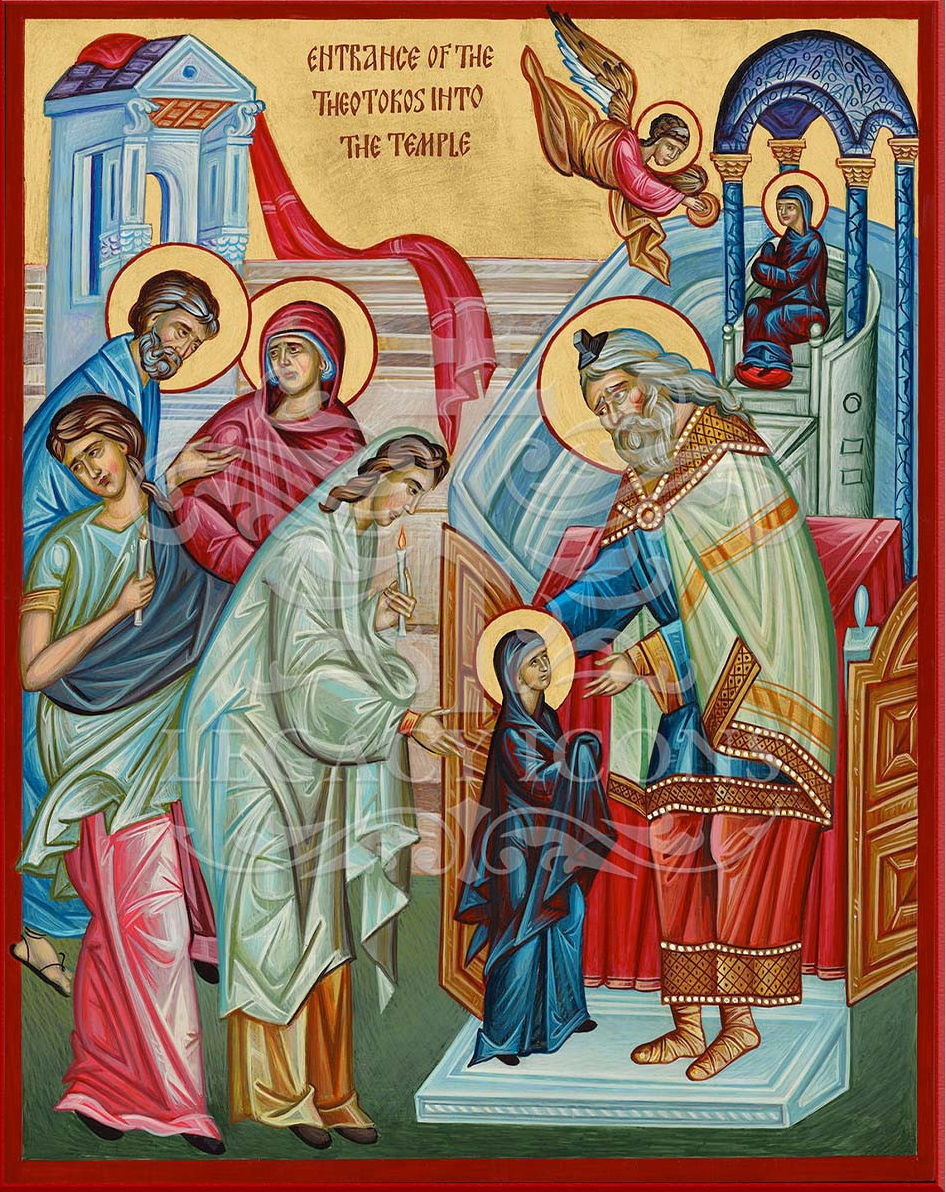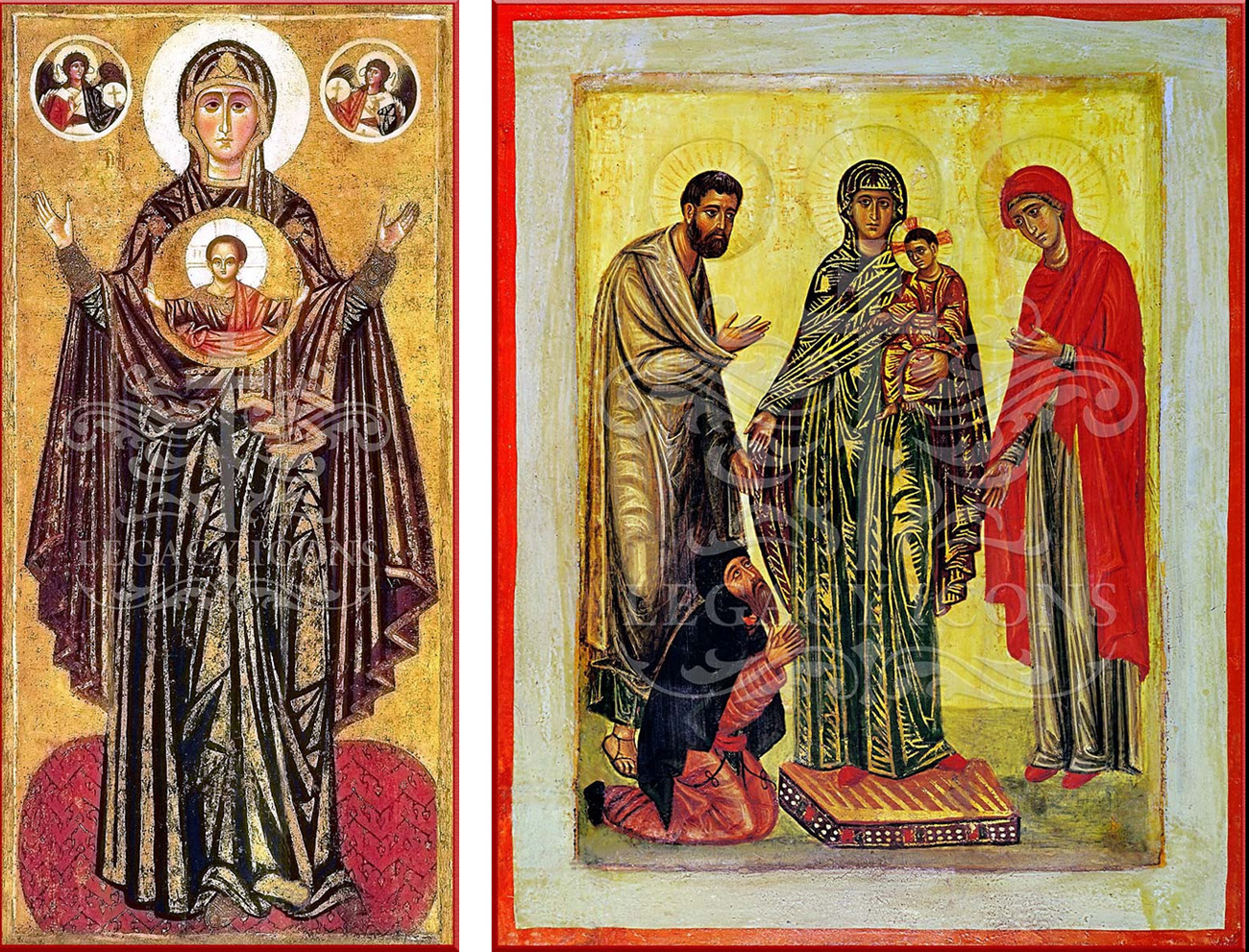The Theotokos, True Temple of God
This post comes from an email in the "Walk Through the Church Year" series which goes out to folks who sign up to receive two emails per month about major feasts and selected commemorations in the liturgical calendar. To receive these emails in your inbox, sign up here.
The original email was sent out in November of 2024.
by Ephraim

Entrance of the Theotokos, contemporary, by the hand of Georgi Chimev;
On November 21, we commemorate the Entrance of the Theotokos into the temple.
She was brought there by her parents in order to be raised up in service to the Lord by the Priest Zacharias, father of John the Baptist, and to be “nourished by angels” in preparation to become herself the temple, to receive the Christ child for the salvation of the world.
For some reason, the feasts around Mary cause me to wonder, in the best way, more than other feasts of the Church. They are truly anagogical, lifting us up to a higher understanding, and always to Christ. Her place in the story is woven throughout the Old Testament in its typology and it is in those passages where I find the most understandable demonstrations of God’s heart for us and His creation. He who the universe cannot contain willingly and humbly deigned to be contained within her in order to become one of us!
I explored some of this wonder with my colleague Reader John, who always seems to have good insight when I ask questions:
Ephraim: You’ve said before that this feast is one of your favorites to celebrate as a choir member or chanter; why?
Reader John: There is a great richness and variety in the liturgy of this feast, filled with Old Testament symbols and how the Virgin fulfills them. In my own imagination, this feast is the best illustration of Psalm 44, which is sung on many feasts of the Theotokos:
“Listen, my daughter, and see, and incline your ear; and forget your people and your father’s house, and the King shall desire your beauty.” This is a perfect illustration of the feast! I can just imagine these verses going through her mind as she runs up the holy steps of the Temple. Especially memorable to me is the long canon in Matins, which gives the priest a lot of time to fill the church with incense during the Ninth Ode! And it is also the first time we sing the Katavasiae of the Nativity, which is always one of the highlights of the Advent season in the Orthodox Church.

Left to Right: Theotokos the Sign, 13th century Russia.Icons of this type are celebrated November 27; Ancestors of God Joachim and Anna with Christ and the Theotokos, from Saint Catherine’s Monastery on Mt Sinai.
Ephraim: We read that this feast celebrates the end of the physical temple in Jerusalem; can you say more about that?
Reader John: In the timeline of history, this is the last time we see the Theotokos before the Annunciation. Her entrance into the Temple marks a turning point in the history of our salvation: it is the final page of the Old Covenant. As the hymns of the feast say over and over: “the Temple enters the Temple!” Inside the old Temple of Judaism, we see the Theotokos, the true Temple of God. The symbol made of stone encounters its living prototype. The next time we see the Theotokos, she will be receiving God in her womb, incarnate as our Lord Jesus Christ, and from then on, human nature and the whole universe is changed. This feast is a joyful anticipation of God’s work that is to come.
Ephraim: We moderns (postmoderns?) may find it so far from our understanding how parents could send their daughters to live in the care of a temple priest for so many early years; how do you make peace with or reconcile that as a member of the modern world?
Reader John: Having a young daughter of my own, I really can’t imagine it. It is a testament to Saints Joachim and Anna, their faith and faithfulness. True to their promise, they dedicated her to the service of God, much like Hannah with Samuel. There are many examples of saints being given over to the Church at a young age—we just celebrated the feast of Saint Willibrord, who was entrusted to the care of a monastery as an infant. We can’t imagine doing that in our world.
There is a lesson here about recognizing God’s work within our children and enabling that to flourish. Our children are not ours; they belong to God. We are responsible for them, and must be faithful and nurture them to respond to God, so as they grow up, they may be faithful on their own. Just as Joachim and Anna brought her to the Temple, young Mary then took the rest of the steps on her own, running to the Holy of Holies. Her parents enabled her to grow spiritually into the singular woman who would give birth to God. She was nourished by the hands of angels in the Temple, the Church’s hymnody says. Her parents had to let go of her so she could become the Theotokos.
Ephraim: How can a person celebrate or mark this feast at home?
Reader John: Attending church services is the most important way to celebrate the feast. It has a very short afterfeast period, so depending on when it falls in the week, you could miss it entirely if you only go to church on Sundays! It is a beautiful feast and well worth the effort in the midst of the Nativity Fast.
The Church relaxes our fast on this day, allowing fish and wine in celebration of this joyful feast. So to celebrate at home, we can have a special family meal, and as a devotional theme, consider what it means for each of us to be temples for God. And reflecting on Joachim and Anna, what is something that we can do to help someone else to grow spiritually?
Ephraim: Thank you for these thoughts Reader John. The wonders continue and this is a big boost for me as we enter the fast.It is all most profound and we get so much true enlightenment from commemorating these feasts every year!


